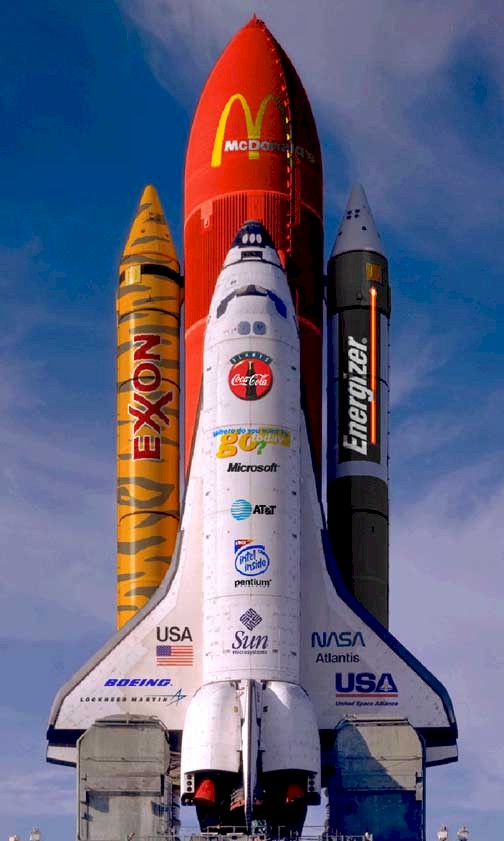Should We Advertise for Christ?
 Florida Space Coast- Apr 1, 2010:
Florida Space Coast- Apr 1, 2010:
Every day we are slammed with requests to buy this or subscribe to that. Billboards appeal to our sexual desires, our food choices, changing our hair color, loosing weight, or appealing to our compassion. While driving to work, radio commercials share the ride with true content only a small percentage of our travel time. Television is no better. Commercials have higher volume than the programs we tuned in to watch. We are shouted at, emailed to, seduced and frightened into giving up our attention and often our values to get the “deal”.
This constant barrage of requests is directed at all age groups. Peer pressure to own THAT car or be seen wearing THOSE shoes is real. The requests are overt. They are on cereal boxes, sides of buses, on park benches and in Internet searches. Children are manipulated to ask for the popular toy or movie relics. Sport teams hawk shirts, hats, and even underwear. It takes significant effort to avoid advertisements on a minute to minute basis.
How can we put God first in this cacophony of worldly requests? With so many asking for our attention, reflecting on the importance of God in our lives seems reserved to the time we spend in houses of worship. One answer of putting God more into our lives is to reserve time each morning and evening to thank Him for what He does for us each day. The moment we first wake and the seconds before we sleep are wonderful commercial free times to have conversations with God.
So what has this posting have to do with Cross on the Moon? The answer is in the belief that corporate advertisements will not stop. Sponsorships for big projects will always be needed. Building private spaceships to reach the moon and perform work there will require investors. Advertising helps pay for the mission when tax-funded programs fade away.
Private corporations will place a mobile machine on the moon before the end of 2014. One task the small rover has will be to travel the length of 5 football fields or more. The rover has to broadcast to the earth in high definition television. It will be a global event, complete with advertising campaigns before, during, and after the machine crawls or hops its way across the lunar surface. Advertising will help offset the mission costs. The unmanned event on the moon will be hard for the public to ignore. Many will say it will be historic because it will be a moon landing accomplished by private enterprise, not by a government. As always, financial support of risky projects is difficult but even more so when done privately. Still, sponsors of the successful moon mission have an incredible opportunity for a global audience.
The total cost for the mission will be over $100 million. We know this from past lunar missions. There are a lot of technical risks but over 30 teams have entered the competition. Google along with the X Prize Foundation, a non-profit charity has offered a $30 million incentive to the first privately funded team to accomplish their mission. They are offering a prize as a catalyst, in the same spirit as sponsoring the crossing of the Atlantic by powered flight that Charles Lindberg won. When he landed in Paris, few people imagined the business that air travel is today. Many entrepreneurs believe the moon can sustain future industries. For the companies that take a risk, one reward is advertising their logos while the rover has power to broadcast.
In the Google X Prize requirements, the lunar rover must look at itself at one point in the mission and broadcast by television the Google Lunar X logo applied to its chassis. Other sponsor logos can surround Google’s logo but center attention belongs to Google.
Cross on the Moon believes a simple cross decal should be on the chassis too. It will unfortunately be nestled with logos of industry giants and brands that want your patronage along with a host of others trying to get your attention. But the Christian cross will be a statement to the billions watching from earth that although mankind applies science and technologies to reach for the stars, we take our passion for Christ with us.
Your Christian decal will not be the largest or the flashiest design on the lunar rover. It won’t have the best placement in the sponsor area. But the symbol of the cross represents eternal life to billions on earth. Without the symbol of faith, we again become overwhelmed by worldly messages and forget who made all things possible.
Let’s not be awed by graphics of corporate sponsors the days when the rover broadcasts from the moon. Instead, we can quietly seek out the plain cross symbol and recognize it for what it means on earth and in your hearts. Understand that it is through faith that all great works of man are done. The men and women who design the rockets, assemble the rover, and guide it on its mission have relationships with God. They attend church, pray regularly, and make moral decisions and raise families based on the person and works of Jesus Christ. The machine that goes to the moon and the rover that travels on its surface will be a brief extension of us. Faith is an integral part of our being human.
Any machine man places on the moon will eventually loose power and stop broadcasting. It will be forgotten in time. No one will see the machine from earth, even with a powerful telescope. However, the rover that goes to the moon will far outlast any man-made artifact on earth, even the Egyptian pyramids. Therefore, we think it is fitting that such a persistent object, destined to be viewed by billions, be graced with our connection to Jesus.

